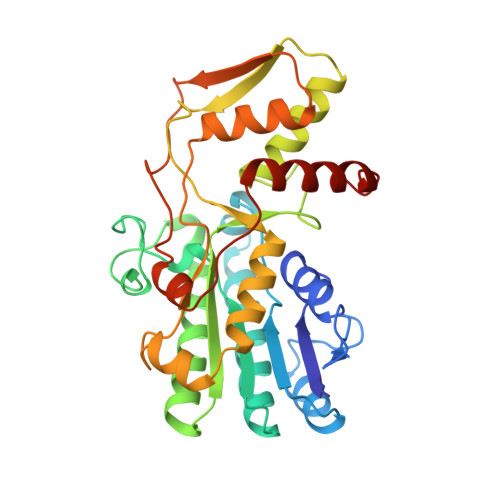GDP-fucose synthetase from Escherichia coli: structure of a unique member of the short-chain dehydrogenase/reductase family that catalyzes two distinct reactions at the same active site.
Somers, W.S., Stahl, M.L., Sullivan, F.X.(1998) Structure 6: 1601-1612
- PubMed: 9862812
- DOI: https://doi.org/10.1016/s0969-2126(98)00157-9
- Primary Citation of Related Structures:
1BSV, 1FXS, 1GFS - PubMed Abstract:
. In all species examined, GDP-fucose is synthesized from GDP-mannose in a three-step reaction catalyzed by two enzymes, GDP-mannose 4,6 dehydratase and a dual function 3, 5-epimerase-4-reductase named GDP-fucose synthetase. In this latter aspect fucose biosynthesis differs from that of other deoxy and dideoxy sugars, in which the epimerase and reductase activities are present as separate enzymes. Defects in GDP-fucose biosynthesis have been shown to affect nodulation in bacteria, stem development in plants, and are associated with the immune defect leukocyte adhesion deficiency type II in humans. . We have determined the structure of GDP-fucose synthetase from Escherichia coli at 2.2 A resolution. The structure of GDP-fucose synthetase is closely related to that of UDP-galactose 4-epimerase and more distantly to other members of the short-chain dehydrogenase/reductase family. We have also determined the structures of the binary complexes of GDP-fucose synthetase with its substrate NADPH and its product NADP+. The nicotinamide cofactors bind in the syn and anti conformations, respectively. . GDP-fucose synthetase binds its substrate, NADPH, in the proper orientation (syn) for transferring the 4-pro-S hydride of the nicotinamide. We have observed a single binding site in GDP-fucose synthetase for the second substrate, GDP-4-keto,6-deoxy-mannose. This implies that both the epimerization and reduction reactions occur at the same site in the enzyme. As is the case for all members of the short-chain family of dehydrogenase/reductases, GDP-fucose synthetase retains the Ser-Tyr-Lys catalytic triad. We propose that this catalytic triad functions in a mechanistically equivalent manner in both the epimerization and reduction reactions. Additionally, the X-ray structure has allowed us to identify other residues that are potentially required for substrate binding and catalysis.
Organizational Affiliation:
Small Molecule Drug Discovery Genetics Institute, Inc. 87 Cambridgepark Drive, Cambridge, MA 02140, USA.














